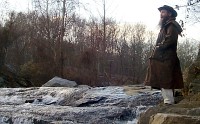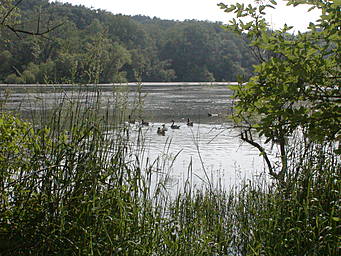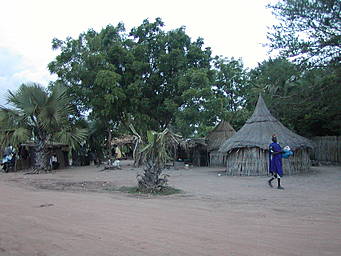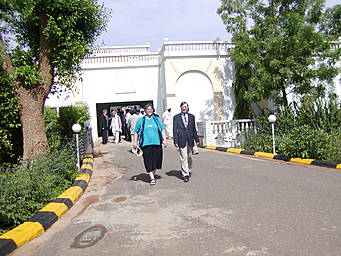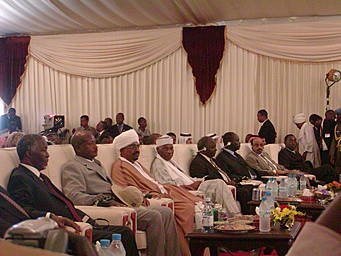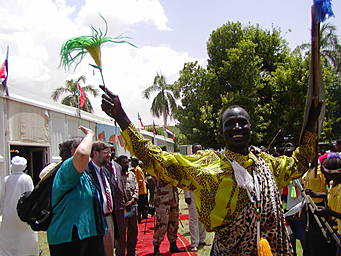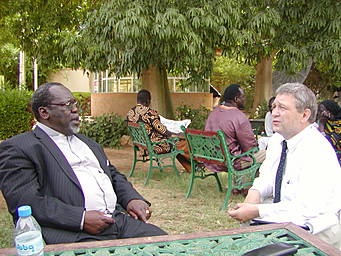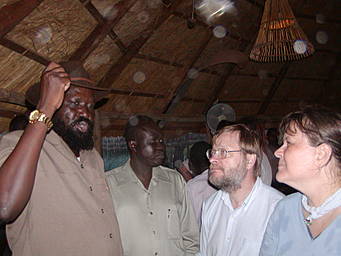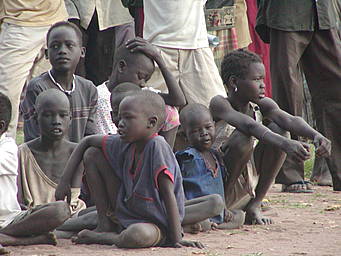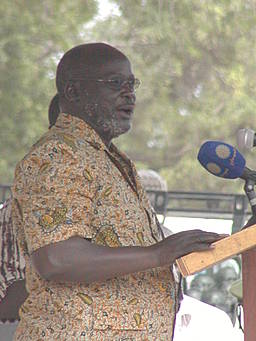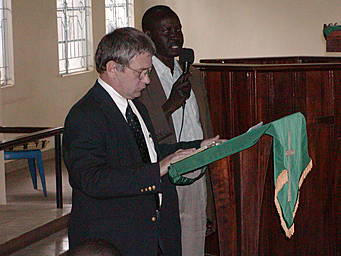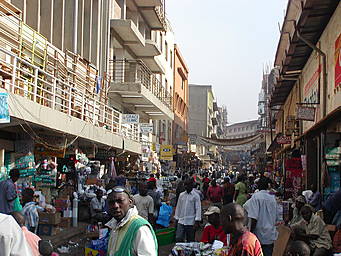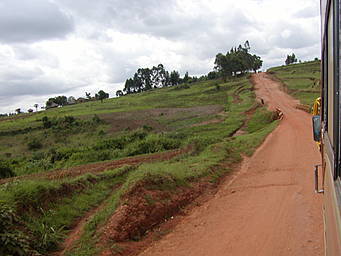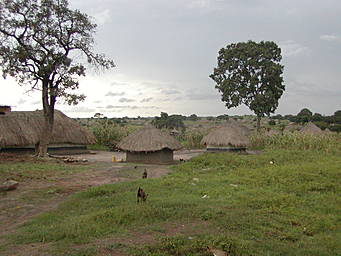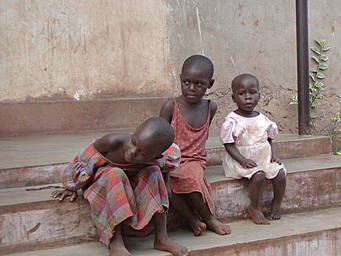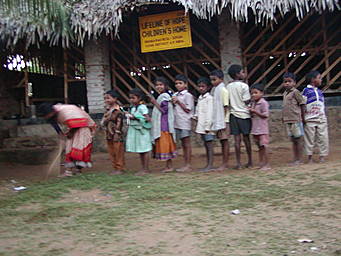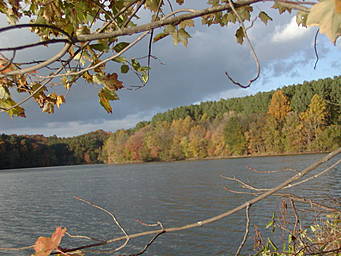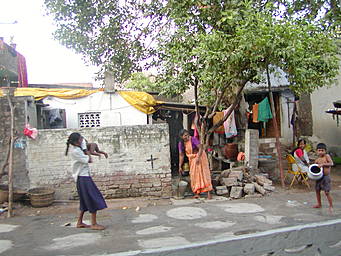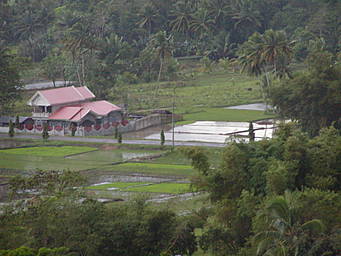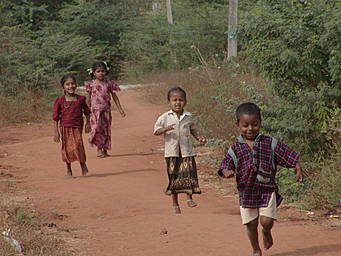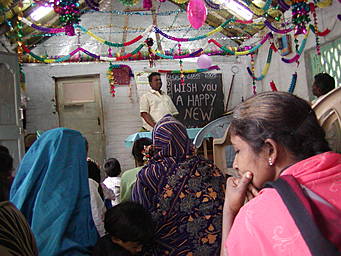2005 in Retrospect
Now 2005 is almost at a close, and it is time to
look back over the year and reflect. What a year it has
been! So much of what happened earlier this year seems to be more
than an age ago, so much so that much of what was before 2005 seems
more recent than the early parts of this year. On this day last
year, I had no clue of the things that were about to transpire, the
places I would go or the things that I would be doing in 2005.
 |
Just as historians date centuries from dates
other than the zero year (thus the 19th century may be said to be from
the fall of Napoleon to the outbreak of WWI), 2005 for me began at 6:30
AM local time on 26 December 2004, when I was awakened by an earthquake
happening a thousand miles away just off the coast of Aceh,
Indonesia. Four and one-half hours later the tsunami slammed into
the coast of South India, changing millions of lives forever, mine
included. Soon I has deep in process of assessing tsunami damage
and facilitating the channeling of funds from the churches in America
to the tsunami-stricken people of India through the Indian churches.
 |
At the same time I was just beginning to work
into my new role as a volunteer for Lifeline of Hope, visiting and
photo-documenting one orphanage and sending co-workers to visit another
as they traveled on tsunami-damage survey. At that time I had
only known of the existence of Lifeline of Hope for three months, and I
certainly did not know that within a year I would be working full-time
for Lifeline.
Also at that time I was able to continue, partially,
with my series of seminars for preachers and pastors, holding one more
seminar in Errebalam, Guntur District but canceling the one in
Machillipatanam because of a time conflict with the arrival of the
American team from HHI.
I was asked by Don Yelton of Whites Ferry Road
Church of Christ Disaster Relief to assess the tsunami damage,
particularly to the Churches of Christ and their members. With
the help of Indian brethren I was ale to make a detailed assessment of
the nearest three districts, and to make reasonable estimates of the
remaining twenty. Then I was asked by Healing Hands International
of Nashville, Tennessee (HHI) to arrange accommodations, itinerary and
transportation for a team they were sending from the USA. When
that team arrived, I was able to meet them with itineraries,
translators and rail tickets, and to accompany one of the teams as they
traveled up and down the coast evaluation damage and making
arrangements for relief. (For
more about the work in India, see my India
report).
When I left India in March, my plan was to stay in
the USA a few months, raise support, and then return to India to
complete my Telugu studies, become fluent in that language, and
continue the work of teaching and mentoring preachers and pastors in
Andhra Pradesh, India. However, raising support proved more difficult
than I had hoped, and I set out to temporarily resume either my old
career of computer design engineer or my recent occupation of schoolbus
driver. But computer jobs were in short supply, and a petty and
spiteful decision of a minor bureaucrat blocked me from driving a
schoolbus. But God had other plans, because if I had had either
of those jobs I would not have been free to go off to Africa on short
notice.
For nearly thirty years I had been involved in
missions to Sudan in the "holding the baggage" role and as an
encourager of those who actually went. For the past half-dozen
years I had helped the refugees from Sudan in the USA in various
ways. But I had no idea that in 2005 I would actually be going to
Sudan, and not only to South Sudan, but to Khartoum, the capitol of the
oppressive and genocidal Muslim government. But at the beginning
of June, I received a phone call from Deborah Martin, who with her
husband Henry had been missionaries to Sudan dating back to 1981.
Henry and Deborah had been invited by the SPLM (Sudanese Peoples
Liberation Movement, the political wing of the SPLA) to attend the
inauguration of John Garang, chairman of the SPLA, as First
Vice-President of the Republic of the Sudan. Two days later I had
my invitation to be part of the SPLA/SPLM delegation from Tennessee as
the delegation's photographer. By the first week in July I was in
Nairobi.
The Martins, meanwhile, had ended up flying into
Khartoum straight from London, after having narrowly escaped the
bombings there. So with the help of God and the Christians among
the Sudanese refugees in Kenya, I was able a few days later to meet
with the SPLM and fly with them on a chartered airliner to
Khartoum. That night, I was quartered with a group of SPLA
(Sudanese Peoples Liberation Army) officers. The next morning, I
met up with the Martins, who announced to their friends "We have found
the lost Kwaja (white person)."
Later that day, we crowded into the big tent on the
grounds of the Presidential Palace with dozens of heads of state, about
a hundred diplomats, and fifteen-hundred other guests for the
inauguration. Only three-hundred seats had been reserved for the
SPLM, so it was a very high honor for us to be given seats. Apart
from the State Department employees and a few returned Sudanese
refugees, we were the only guests from the USA. I was hustled
into the press corps area with the photographers from BBC and
al-Jazeera, and I joined in the "media feeding frenzy" when Koffi Annan
entered the tent and took his seat.
First al-Basheer was sworn in as President of the
new coalition government, then Dr. Garang was sworn in as First Vice
President, finally Taha was sworn in as Second Vice President. By
the terms of the Comprehensive Peace Agreement (CPA) signed 9 January
2005, the head of the SPLA is ex-officio the First Vice President of
the Republic of Sudan, and also President of the Autonomous Region of
South Sudan.
Then we spent three days in Khartoum rejoicing with
the officers of the SPLA over an end to twenty-five years of war.
There was also serious business to be done as each of us had to find
the appropriate officials of the new government and begin discussions
of how we could help in the rebuilding process. In my case, this
meant finding the officials in charge of programs for the care of
orphans, because Lifeline of Hope, who had sent me to Sudan, wants to
become a part of the solution to this massive problem.
Before our rejoicing and our business was complete,
the Southern Sudanese officials began flying south to their new
provisional capitol at Rumbek, and they asked us to join them
there. So, with only one bag packed for three days in a hotel in
a modern city in the desert, off I flew in a Russian troop-transport to
a tent camp for three weeks in the jungle in the rainy season.
While there, we were able to meet with many of the
cabinet members, governors and other leaders of the southern
government, including Deborah Martin's particular friend Salva Kiir,
who welcomed her and Henry with open arms. Salva had been the
military head of the SPLA for years, and at that time was Vice
President of South Sudan. God tremendously blessed our time in
Rumbek. He opened the doors and provided the opportunities for us
to be of service to the new government in ways that cemented the bonds
of friendship between ourselves and them.
Also while in Rumbek the cabinet members in whose
responsibilities include orphan care were particularly interested in a
vision for culturally appropriate childcare centers, and asked me to
develop this as a model program for the entire South.
Too soon we had to leave, but the Martins had
responsibilities waiting for them in Nashville and I was prostrated by
a systemic fungal infection. In Nairobi I was able to get the
appropriate medicine, and one day later the Martins flew to the USA,
leaving me in the care of the Sudanese community in Nairobi. The
next next day we began to hear disquieting rumors, then on Monday we
were shocked to hear the rumors confirmed: Dr. John Garang had died in
a helicopter crash. Everyone braced for a resumption of the
twenty-five years of war so recently ended. Fortunately, the war
never came. Salva Kiir, now First Vice President of Sudan and
President of South Sudan, skillfully led his people through the crisis
and what little violence did break out quickly died away.
But my plans for the month of August were
shattered, as my hosts were key figures in Dr. John's funeral
arrangements. So I was handed over to another part of the
Sudanese community, and made new plans.
Lifeline of Hope had been for some time sponsoring
two orphanages in Uganda, and had just begun sponsoring three
orphanages in Kenya. In addition, an orphanage in or near Yei,
South Sudan, had applied for assistance from Lifeline, but the
evaluation process had not been completed because of the lack of
volunteers to go to Yei in the midst of a civil war and make an on-site
inspection. Yei has a bad reputation for landmines casualties
even within the city limits. There were other reasons no-one
wanted to go to Yei which I was not aware of. So I decided that I
would go to Yei, do the on-site evaluation and photo-document the
orphanage. Then if possible on my way back to Nairobi I would
visit and photograph the orphanages in Uganda.
The trip from Nairobi to Kampala, the capitol of
Uganda, takes twelve to fourteen hours by bus. We arrived in
Kampala on a Saturday, and I elected to stay over Sunday, both to rest
and to go to church. Then on Monday very early we set out on the
fourteen or more hour bus ride to Yei. At Murchison Falls we had
to wait while a convoy was formed; I assumed it was to prevent people
from stopping and poaching game in the national park. But it was
very curious how many hulks of tanks and armored cars we saw abandoned
along the road. My main worry was the condition of the road. It
was raining, and the bus was sliding all over the dirt road. Two
buses ahead of us slid out of control into the ditch. But we
arrived safely in Yei at last.
The next day I was able to visit the orphanage at
its "secret location" in the middle of a teak plantation. While
in Yei we heard that the road we had just traveled was closed due to
mud and high water. When it re-opened, we took the bus back to
Kampala. In Kampala, I finally found out the real reason no-one
would visit the orphanage in Yei. The road I had just traveled
twice went through territory controlled by the Lords Resistance Army
(LRA), one of the most vicious terrorist groups on the planet.
Which explains the burnt-out armored vehicles along the road.
Visiting the orphanages in Jinja, Uganda, was not
nearly so difficult or dangerous, it merely required a helmet-less
motorcycle ride on a rough mountain road. And the children of
course are beautiful. Then I returned to Nairobi.
It was at about this time that Lifeline of Hope
invited me to join that organization fulltime. It took several
weeks to work out the details, but I was glad to accept the offer from
the beginning. I had already formulated a vision of what I think
is the best model for Christian missions from the USA (and other First
World countries) to the Third World in the Twenty-First Century, and
the work that Lifeline of Hope is doing conforms exactly to that
vision. (see http://www.lifelineofhope.org
)
In October, I was able to attend the World Mission
Workshop; this year it was at Harding University in Searcy, Arkansas,
USA.
In November, I packed all my things (my home is now
"on the road") and set out for India. I was only there a short
time, visiting one orphanage and making plans with my translator and
other assistants for my work there in January and February.
At the beginning of December I flew via Hong Kong to
Cebu, Philippines and the next day took ship for Bohol, where I am
today. Earlier this week I flew to southern Mindanao to visit an urban
children's ministry and a rural tribal evangelism and assistance work.
Orphanages have been proposed for both locations and these sites needed
to be evaluated. In the first week of January I will take the
ferry to northern Mindanao to visit an orphanage already sponsored by
Lifeline.
In the second week of January I fly back to
India. That will be, I think, the appropriate punctuation mark to
say is the real conclusion of 2005 for me.
Kenneth A. Grimm
Christmas 2005
Edited 1 April 2007
